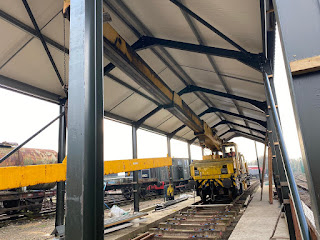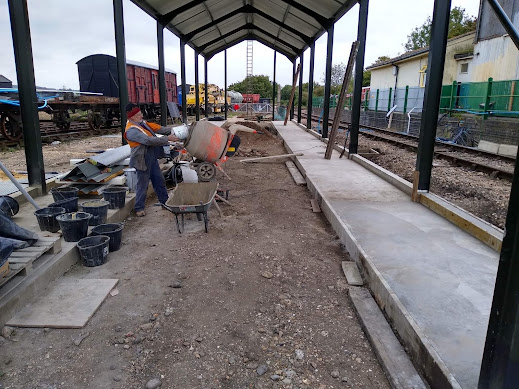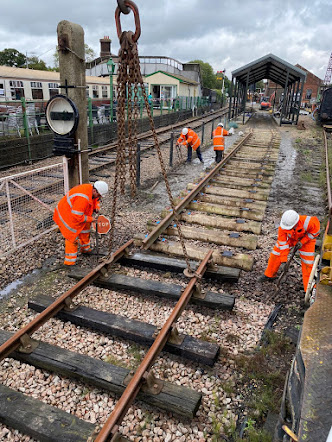Chappel News Review of 2020
Just what has been achieved at the museum this year? The answer is quite a
lot between lockdowns, as an unintentionally given active members a break from staging events. Much has
progressed, the best examples being Miniature railway, Running Shed and N7 Suburban
tank locomotive.
|
Museum AGM
advanced notice [on Zoom 9th January 2021] |
CN83 27 10 20 |
|
A picture
that could say a thousand words |
CN83 27 10 20 |
|
Carry on :
Carrying on Museum opening times |
CN83 27 10 20 |
|
Donation of
railway carriage prints |
CN83 27 10 20 |
|
FUND RAISING
SCHEMES |
CN83 27 10 20 |
|
London
Suburban tank in N7 locomotive |
CN83 27 10 20 |
|
Museum
Objects: Furlough tickets |
CN83 27 10 20 |
|
October 2020
workshop round up |
CN83 27 10 20 |
|
Rapid
progress in building the Running shed |
CN83 27 10 20 |
|
The View from
space Quiz! |
CN83 27 10 20 |
|
Waste
disposal is costing the museum money.! |
CN83 27 10 20 |
|
Web based
museum reporting: |
CN83 27 10 20 |
|
August 2020
Chairman's statement |
CN82 24 08 20 |
|
August Photo
Miscellany |
CN82 24 08 20 |
|
Building
developments, steel skeletons and plans |
CN82 24 08 20 |
|
Front of
house news from Neil Temlett |
CN82 24 08 20 |
|
Fund Raising
schemes |
CN82 24 08 20 |
|
Halstead
developments [modelling in MRC public access room] |
CN82 24 08 20 |
|
Photographic
Charter 15th August / 30742 Charters |
CN82 24 08 20 |
|
Restoration
of N7 locomotive [starting the boiler lift] |
CN82 24 08 20 |
|
Longer term
thinking - Exhibition Hall |
CN81 16 07 20 |
|
I-spy with my
little eye |
CN81 16 07 20 |
|
Covid
lockdown 1 - eases / Furlough Planning Decision due / digest of small improvements |
CN81 16 07 20 |
|
Wickham
Bishops model railway model |
CN80 17 05 20
|
|
EARM Photos
and Quiz pages (Whatsapp group) |
CN80 17 05 20
|
|
Engines of
War at Chappel (photo feature) |
CN80 17 05 20
|
|
Jubilee's
Cambridgeshire hide-away and its vintage coach partner |
CN80 17 05 20
|
|
September
Beer Festival (discussion about go/no go decision) |
CN80 17 05 20
|
|
Museum
finances and Essex Lottery for good causes |
CN80 17 05 20
|
|
Volunteers
input during general site closure (Covid19 virus shutdown) |
CN80 17 05 20
|
|
Curators
update - Wickham bishops Trestle bridge layout - 8 boxes of Takeley station
archive - New Local Lines display boards due soon |
SVS168 Spring
2020 |
|
Dept. of
Model railways - Open members night Mondays, but also on Thursdays |
SVS168 Spring
2020 |
|
Detailed
explanation of DRB restoration - Peter Martin - AEc220LX engine, Electrical
problems, Body Corrosion, Monocoque construction |
SVS168 Spring
2020 |
|
Drewry
Gardner 838/230 "WD loco" (WD72229) purchased by the museum -
History of its use and deployments - Isaac Ferneyhough |
SVS168
Spring 2020 |
|
Estates -
Platform 2 café toilets upgrade to an accessible facility - Car Park
groundworks |
SVS168 Spring
2020 |
|
Farewell to
second generation DMUs in East Anglia - Marcus Teyus |
SVS168 Spring
2020 |
|
Lamport works
- Remove foundation ring send a way for new inner firebox - DMU body repairs
and repaint |
SVS168 Spring
2020 |
|
Marketing -
revised logo for Marketing Increase
26% attendances - Wear and tear on site - Catherine Harrison |
SVS168 Spring
2020 |
|
Martin
Gibbons - Volunteer News |
SVS168 Spring
2020 |
|
Start of the
Coronavirus pandemic - Editorial |
SVS168 Spring
2020 |
|
The Future of
Stour Valley steam - call for ideas = Editorial team [David Reeve and Darren
Johnson] |
SVS168 Spring
2020 |
|
Thompson
bench - former Thorrington station bench restored |
SVS168 Spring
2020 |
|
Thompson
Green MR2 station construction - MR" loco shed, benches and power. Track
cast in apron area for servicing |
SVS168 Spring
2020 |
|
Updated and
renumber extensions - VOIP Digital communications - Brian Mc Gennity |
SVS168 Spring
2020 |
|
Engineering
training at Chappel |
CN 79 March
2020 |
|
Further notes
on B12 locomotive donation - Clive Rey |
CN 79 March
2020 |
|
P Way
maintenance |
CN 79 March
2020 |
|
Real Time
Trains |
CN 79 March
2020 |
|
Signalling
course January 25th |
CN 79 March
2020 |
|
The night the
railway changed - 20/21st January 2020 |
CN 79 March
2020 |



























